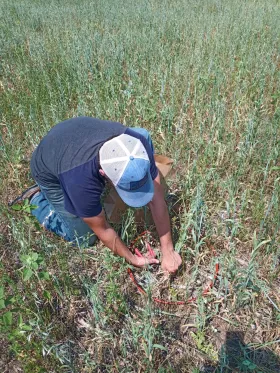Number of plots: three
Clipping area: We recommend that the length be divided between two adjacent rows.
- 22-inch row spacing: length of 6 feet
- 24-inch row spacing: length of 5 feet 6 inches
- 30-inch row spacing: length of 4 feet 3 inches
- 36-inch row spacing: length of 3 feet 8 inches
Conversion rate: 8.92
Clipping length is calculated as
10.8 ÷ (row spacing in inches ÷ 12) = length in feet
Make sure samples represent the variation within the grazing unit. The more variability in the pasture and forage growth, the greater the number of samples necessary. In crop settings, collect more samples if the stand is not uniform.
Example 1
To determine production of a meadow brome pasture, clip five 1.92-foot2 frames using the air-dry method.
- Record the wet weight for each plot, subtracting the bag weight (5 grams in this example).
- Air-dry the samples and reweigh to determine the dry weight of each sample, subtracting the bag weight of 5 grams.
- Determine the average dry weight of the five samples = 41 grams
- Multiple the average dry weight by the conversion factor: 41 grams x 50 = 2,050 pounds/acre
|
Plot
|
Total Weight (grams) – includes bag
|
Wet Weight (grams) – minus bag
|
Percent
Air-dry Matter
|
Dry Weight
(grams)
|
|
1
|
98
|
93
|
35.5
|
33
|
|
2
|
120
|
115
|
33.9
|
39
|
|
3
|
113
|
108
|
36.1
|
39
|
|
4
|
150
|
145
|
35.2
|
51
|
|
5
|
135
|
130
|
33.1
|
43
|
|
Average Dry Weight: 41
|
Example 2
To determine production of a meadow brome pasture, clip five 1.92- foot2 frames and multiply by dry weight conversion. Meadow brome grass is in the before-heading growth stage (Table 2).
- Record the wet weight for each plot, subtracting the bag weight (5 grams in this example).
- Multiply weight by 35% (0.35, Table 2) to determine the dry weight of each sample, subtracting the bag weight of 5 grams.
- Determine the average dry weight of the five samples = 42 grams
- Multiple the average dry weight by the conversion factor: 42 grams x 50 = 2,100 pounds/acre
|
Plot
|
Total Weight (grams) – includes bag
|
Wet Weight (grams) – minus bag
|
Percent
Air-dry Matter
|
Dry Weight
(grams)
|
|
1
|
98
|
93
|
35
|
33
|
|
2
|
120
|
115
|
35
|
40
|
|
3
|
113
|
108
|
35
|
38
|
|
4
|
150
|
145
|
35
|
51
|
|
5
|
135
|
130
|
35
|
46
|
|
Average Dry Weight: 42
|
Example 3
To determine production of a row crop seeded at 30-inch row spacing to be used as pasture, clip three separate locations containing two rows at a length of 4 feet, 3 inches long and multiply by dry weight conversion. Plant mixture used in this example is sorghum-sudangrass harvested at the heading stage (Table 2).
- Record the wet weight for each plot (3), subtracting the bag weight (15 grams in this example).
- Multiply weight by 45% (0.45, Table 2) to determine the dry weight of each sample, subtracting the bag weight of 15 grams.
- Determine the average dry weight of the three samples = 365 grams
- Multiple the average dry weight by the conversion factor: 365 grams x 8.92 = 3,256 pounds/acre
|
Plot
|
Total Weight (grams) – includes bag
|
Wet Weight (grams) – minus bag
|
Percent
Air-dry Matter
|
Dry Weight (grams)
|
|
1
|
808
|
793
|
45
|
357
|
|
2
|
894
|
879
|
45
|
396
|
|
3
|
778
|
763
|
45
|
343
|
|
Average Dry Weight: 365
|



